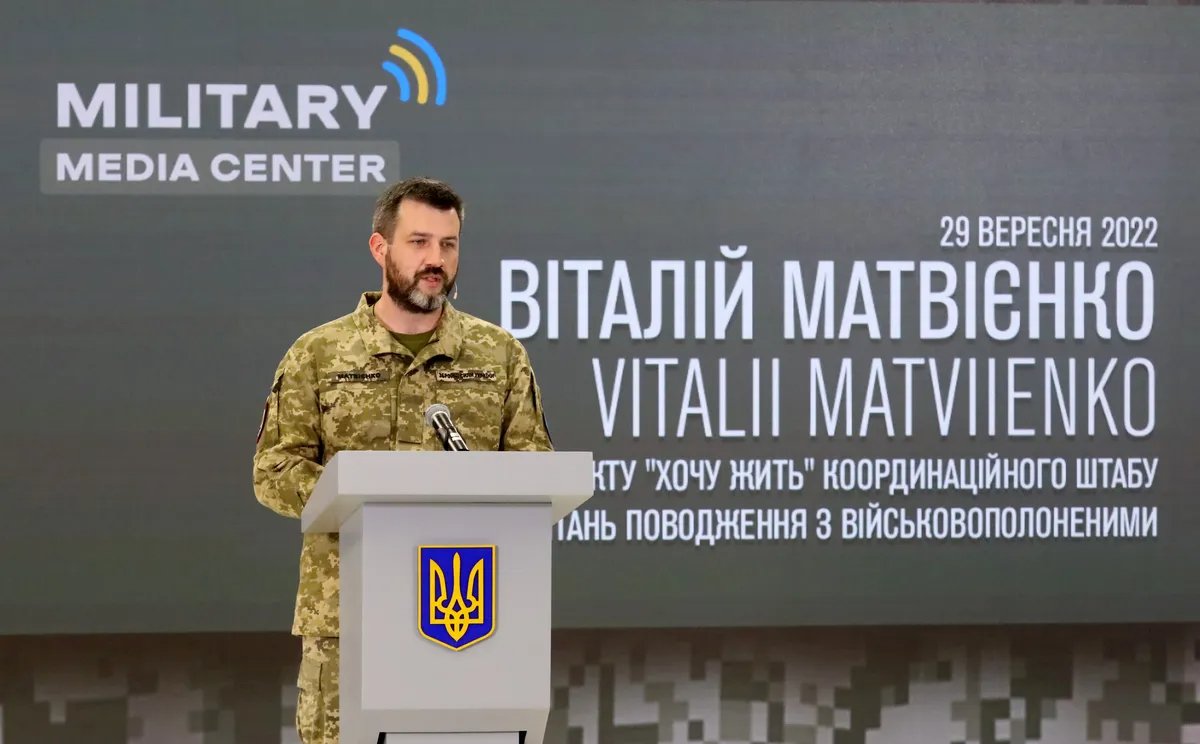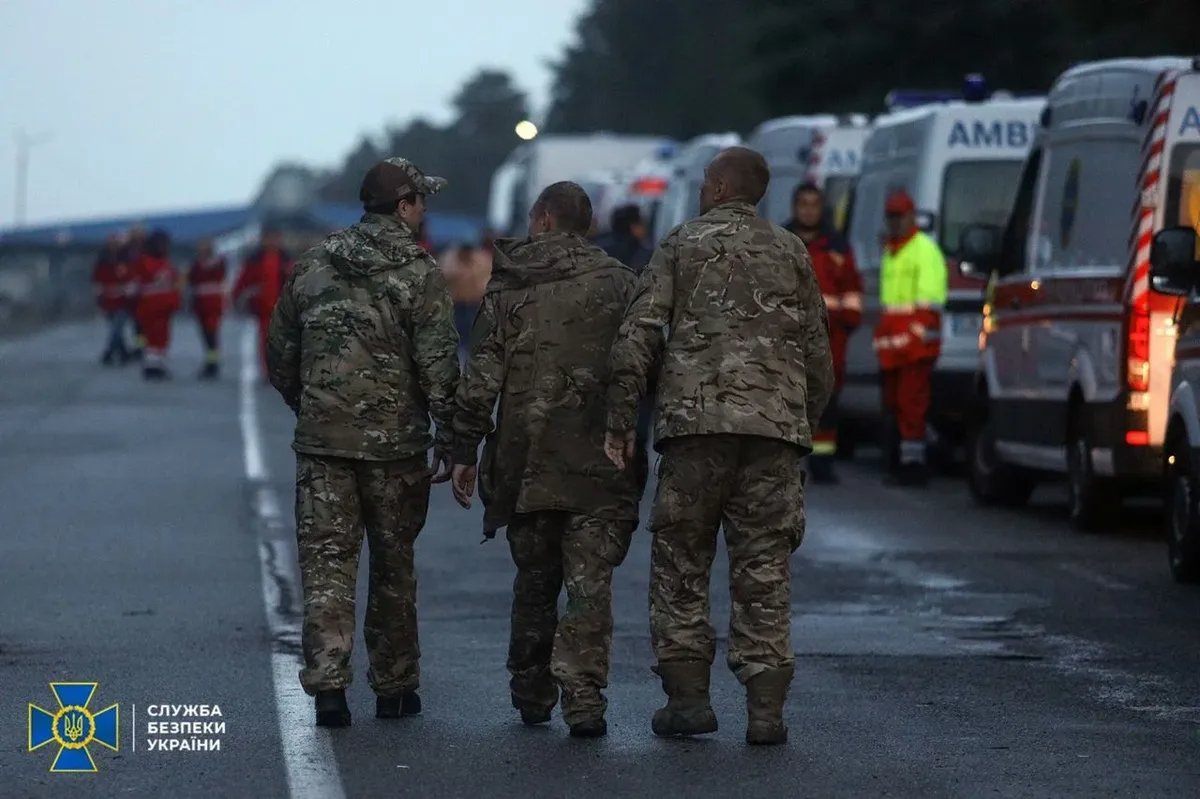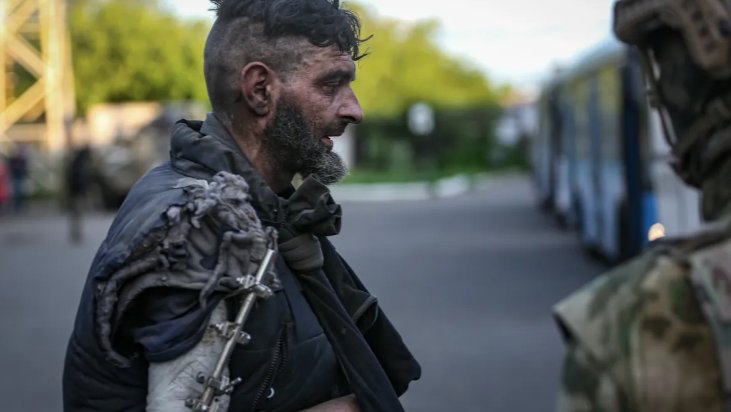There has been no official information about POWs provided by Russia and Ukraine for many months now. On 7 June, Russian Defence Minister Sergei Shoigu announced that 6,489 Ukrainian soldiers had surrendered to Russia. This number included the defenders of Mariupol’s Azovstal steelworks, soldiers of the famed Azov battalion. According to Ukrainian President Volodymyr Zelensky, there were about 2,500 of them in Mariupol. On 23 June, Ukrainian Deputy PM Iryna Vereshchuk said that since the start of the Russian invasion, the number of Ukrainian POWs had reached about 2,000 people. The official stressed that this figure reflects the official number of prisoners confirmed with the help of the International Committee of the Red Cross (ICRC).
“This is a constant process during which we send letters to the ICRC, they then address Russia, and Russia partially confirms the information… So, as of today, we have confirmed that there are approximately 2,000 Ukrainian POWs in Russian captivity,” Vereshchuk said.
Maximum humanity
The number of Russians in Ukrainian captivity is not stated officially. A source of Novaya Gazeta. Europe involved in the organisation of prisoner swaps from the side of Kyiv, explains that this number is difficult to calculate due to the fact that Russian army officers are not the only ones getting captured: “The mobiks (forcibly mobilised soldiers) from the ‘LDPR’ [Luhansk and Donetsk ‘people’s republics’] and National Guard officers surrender in squads. There are also FSB officers, mercenaries from private military companies, and [Chechen leader Ramzan] Kadyrov’s troops: Ukraine finds no pleasure in taking them captive. But it does take them. In total, there are about 6,000-7,000 of them now. Ukrainian commanders have received orders to treat the POWs with maximum humanity. And this is bearing fruit. Men who have been drafted within the ‘partial mobilisation’ in Russia have already begun to surrender.”

Vitalii Matviienko, a spokesman for the I Want to Live hotline set up by Ukraine’s Coordination Headquarters for the Treatment of Prisoners of War. Photo: Volodymyr Tarasov / Getty Images
Kyiv has launched a widespread information campaign calling on forcibly mobilised Russian citizens to lay down their arms. In order to do this, Ukraine has set up the I Want to Live hotline, which has already received over 2,000 calls by servicemen and their families. Ukrainian lawmaker and head of Ukraine’s delegation to NATO Parliamentary Assembly Yegor Chernev says that dozens of newly mobilised Russians are surrendering willingly to Ukraine. The politician stresses that the goal of the Ukrainian army is not to kill as many enemy soldiers as possible, but to liberate Ukrainian territory.
“Russian soldiers who don’t want to commit war crimes or die without honour on Ukrainian land have an opportunity to contact the Ukrainian side on the phone or through a Telegram bot. There, they will receive clear instructions,” Chernev told Novaya Gazeta. Europe. “Besides, some soldiers and units have an opportunity to surrender directly on the line of contact by raising a white flag and approaching the Ukrainian positions with their hands raised in the air.
Fortunately for the Russian POWs, the Armed Forces of Ukraine adhere to the norms of humanitarian law and the principles of humanity, so the Russians can get the most damage to their health if they are captured while resisting.
This is why we are calling on Russian citizens to surrender willingly and voluntarily, to avoid additional injuries or casualties from their side.”
According to Chernev, Ukraine guarantees to adhere to all the provisions of the Geneva Conventions, vowing to provide humane treatment, food, medical aid and normal living conditions in captivity for Russian POWs. The lawmaker notes that Ukrainian and international human rights and humanitarian organisations, including the ICRC, are monitoring Ukraine’s adherence to these norms.
The Ukrainian MP also explains what Russians who do not want to face criminal charges back home for voluntary surrender into captivity can do: “In accordance with the provisions of the Geneva Conventions and international law, these people will not be swapped. They can either stay in Ukraine or seek asylum in other countries, including Europe.”
All newly captured POWs are provided with medical aid, after which they face several interrogations with the participation of Ukraine’s military intelligence and special services. If it is confirmed that the POWs in question did not take part in war crimes, they will be sent to a detention facility. Those who are suspected of any crimes or who fought in Donbas before the start of the “special military operation” are held separately, with Ukrainian law enforcement collecting information on them for court trials. According to Chernev, people who committed war crimes or crimes against humanity, as well as Ukrainian nationals who have been accused of state treason, collaborationism, or siding with the enemy, will be prosecuted in court.

Russian POWs in Ukraine. Photo: a screenshot from the video
Everything is classified
“We’ve been contacted by many relatives of Russian servicemen who ended up in Ukrainian captivity. Our hotlines got the most calls in the first few months of the conflict. It was the most anxious time,” Valentina Melnikova, the executive secretary of the Union of Committees of Soldiers’ Mothers of Russia, told Novaya Gazeta. Europe. “We wrote to the chief military prosecutor’s office; we sent our claimants to the human rights commissioners. Since the swaps began, things calmed down a little. We now have the opportunity to influence the situation. For example, we wrote to the chief of the Moscow region’s military police who deals with ensuring security during the swaps, and asked him to include injured POWs on the list. When prisoner exchanges started to be held on a regular basis, we understood that people do survive captivity.”
According to Melnikova, the Russian state does not provide any information to the relatives of captured soldiers. Everything is classified.
Russian families have no other sources of information besides Ukrainian channels.
“Since early spring, Ukrainians have started publishing photographs, documents and video interviews of Russian POWs. Some human rights organisations have called it a human rights violation and humiliation of the prisoners’ dignity. But in my opinion, this very necessary and correct activity helped a lot of people find their missing or captured relatives,” Melnikova says.
She noted that the soldiers’ relatives are the ones to inform the Russian Defence Ministry that a serviceman was captured, and in the best-case scenario, the ministry confirms this fact. As a rule, only then can a person be included on the prisoner swap lists.
Valentina Melnikova points out that in accordance with the norms set by the Russian Defence Ministry, in case of any emergency situation, the soldiers’ families must be notified of it within three days. This is a responsibility of the military unit’s commander. The contact information of the soldiers’ next of kin can be found in their personal file.
The ICRC has recently started collecting letters from Ukrainian POWs currently held in Russia and handing them over to their families. A similar agreement has been reached regarding Russian POWs in Ukraine. Ukraine also allows Russian prisoners to call home. Valentina Melnikova says that none of the Russians freed from captivity have reported any cases of violent treatment by Ukrainian troops to the Committee. At the very start of the conflict, there could be problems with food supply, personal hygiene items and other conditions of detention. However, this is nothing compared to the way POWs were held back during the Afghan and Chechen wars, she says.
“According to two guys who have been released from captivity, they were treated absolutely fine,” Melnikova notes. “They fed them what they had on hand, and the prisoners received medical treatment if they needed it.” The Ukrainian government earlier stated that 3,000 hryvnias (€83) are allocated from the budget per one Russian POW.
Rumours and horror stories
Back in spring, Russian prisoners of war were kept at Ukrainian detention centres under regular armed guard. After the tragedy in Bucha, there was a surge of violence against Russian POWs. Several Russians were killed, and dozens were severely beaten. Since then, the prisoners have been guarded by military police under the guidance of counterintelligence officers.
Since spring, rumours have spread among Russian soldiers about the horrors that POWs may face in captivity. “Out of 30 guys from Buryatia who came back after a swap, four were castrated. Two of them have killed themselves since then, the rest are abusing drugs,” an officer of the National Guard who wished to remain anonymous says. “What is more, unit commanders take part in the torture.” He was unable to provide the names of the injured soldiers or any additional details. Nevertheless, there is a video online showing Russian POWs being shot. It is not hard to find, just like the shocking footage of castration and subsequent murder of a man wearing a Ukrainian uniform by a Russian solider.
Ukraine does not deny that there may have been cases of torture of POWs. “Violence against POWs is unacceptable, and in these cases, law enforcement bodies investigate these incidents within the limits of their authority,” Egor Chernev says.
“A surge of violations of Ukrainian and international laws protecting the rights of POWs was recorded after the events in Bucha, Irpin, and Hostomel were made public,” a representative of the Ukrainian defence ministry who oversees the living conditions of POWs told Novaya Gazeta. Europe. “Fewer crimes are committed on the home front, and they tend to be smaller violations unrelated to torture or other physical violence. There is a pushback (when it comes to investigating the crimes against POWs — editor’s note) from the side of army units. No one wants to tell on their own. We don’t have the resources to monitor everything that is going on directly on the line of contact. We are monitoring the situation and analysing the reports we get. These reports can be both from our servicemen and the civilians who witnessed war crimes. Since April, we have received over 40 reports. We carried out inspections and launched investigations, which are currently ongoing. Investigation teams are compiling an evidence file for each case. The commanders of army units have been notified that torture or murder of POWs will be punished in accordance with Ukraine’s criminal code and international law.” The source of Novaya. Europe knows of four cases where investigative procedures have concluded, with suspects placed in custody.

A prisoner swap between Russia and Ukraine. Photo: Getty Images
Needles under fingernails
Ukrainian nationals who returned from Russian captivity often report cases of inhumane treatment. Mykhailo Dianov, a defender of Azovstal, recalls that Ukrainian POWs were beaten with batons and tazed. The Russians also pushed needles under the prisoner’s fingernails and starved them. Dianov says that the POWs were given just 30 seconds to eat some pieces of stale bread and drink scalding water. Dianov was beaten during trips to the Investigative Committee: the officers hit him in the head with a rifle. The Azovstal defender said that he could not talk about all the details of his captivity to avoid causing harm to the POWs remaining there.
Another Ukrainian national who returned from captivity, Mykyta Horban, who never even held a gun in his hands, is now disabled. Horban worked as a medic in the Andriivka village near Kyiv. He and the majority of men from his village were captured by Russians. “They asked me where the artillery is, to get something out of me,” he recalls. “They told me to take off my shoes. We were wearing galoshes. They poured water inside our shoes. It was cold and it was snowing. I got frostbite.” Horban was then taken to Russia, and his feet remained untreated for three weeks. At a hospital in Kursk, they amputated his toes and then swapped him. According to the Media Initiative for Human Rights, Russia is holding captive from 5,000 to 7,000 Ukrainians, both soldiers and civilians. “Our law enforcement detained a lot of civilians, accusing them of abetting the enemy,” a Russian officer says. “There are people who did not undergo filtration on occupied territories for various reasons: they are relatives of SBU [Ukrainian security service] and AFU [the Armed Forces of Ukraine] officers, they were mentioned by informants, or they are simply men of draft age. You can be sent to a basement for public support for Ukraine, for a controversial tattoo, for taking videos of military equipment and even buildings occupied by Russians. If they find such a video in your sent messages, they’ll accuse you of espionage. There’s no point explaining that everyone sends these videos to each other on occupied territories, even in school chats. We don’t know how many people like that there are. The number is definitely in the thousands.”
Besides, the Russian serviceman stated that some units had established their own exchange pool. Both sides have dozens, if not hundreds, of people captured in basements. They need them to strike a deal with the enemy on the spot and get their fighters back. These quick swaps are not announced. Soldiers do not trust the military leadership on these matters: “First and foremost, they swap out pilots and Kadyrov’s officers, while regular soldiers spend months waiting. They turn into prisoners of political games, slaves of war.”
Some of the Ukrainian POWs are still held at a prison in Olenivka, where 50 people had been killed in an explosion in July.
Back then, both sides accused each other of a bloody provocation. The Russian Defence Ministry claimed that Ukraine had deliberately attacked their own troops. In turn, Kyiv stated that the tragedy was caused by Russian troops, who tried to cover up the evidence of torture.
Our source in the Russian army said that according to one version of the events, the bodies of Ukrainians, including personal enemies of Chechnya’s head Ramzan Kadyrov who did not survive the torture, were burned there. Everyone who mentioned Chechnya or somehow insulted the Chechen leader in their blogs or video addresses were transported to Grozny. Over 20 people were delivered to Chechnya’s capital. It was reported almost immediately that one of the prisoners had died right during a meeting with Kadyrov.
Quite often, people who undergo torture do not get registered as POWs. Russian and Russia-affiliated troops use “express interrogation” methods on some of the captured soldiers. The so-called Sabotage Assault Reconnaissance Group “Rusich”, fighting on the side of the “LDPR people’s militia”, has recently published an “instruction on the utilisation” of Ukrainian troops. “If possible, do not report the capture of enemy soldiers and officers to the higher command. If there was such a report (to improve accounts), tell them that the enemy is wounded and may die (even if that is not true)” the instruction reads.
During the interrogation, the authors of the “instruction” offer to “chop off fingers, cut off an ear, punch them in the groin and joints, push needles under their fingernails”. After the interrogation, the prisoner should be shot “without attracting attention”.
“The conditions of detention of Ukrainian POWs in Russia can only be compared to the conditions of detention in Auschwitz or Buchenwald,” Yegor Chernev says. “People are starved to an extreme degree of exhaustion, they are beaten and brutally tortured by psychotic sadists. The country that claims it is fighting Nazism essentially behaves worse that Nazis. The organisers and the perpetrators will answer for their crimes, just like the leaders of the Third Reich did at the Nuremberg trials.”
Join us in rebuilding Novaya Gazeta Europe
The Russian government has banned independent media. We were forced to leave our country in order to keep doing our job, telling our readers about what is going on Russia, Ukraine and Europe.
We will continue fighting against warfare and dictatorship. We believe that freedom of speech is the most efficient antidote against tyranny. Support us financially to help us fight for peace and freedom.
By clicking the Support button, you agree to the processing of your personal data.
To cancel a regular donation, please write to [email protected]


